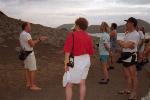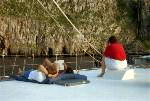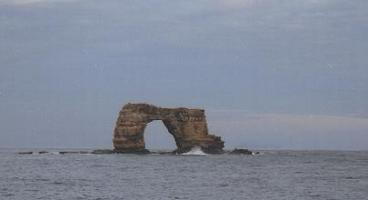| GALAPAGOS & PERU 1997 - Part One
|
Saturday, 3 May, 1997 - Philadelphia - Miami - Quito, Ecuador
At 8:00 a.m., I still had not packed anything (flight was at 12:30). Much sound and fury later, I had filled a huge duffel bag (dive gear), my "flight attendant" suitcase, an Eagle Creek daypack,
and a largish beach bag (mostly books), and was on my way to the
airport to catch my first flight to Miami (American Airlines). I met up with my companions for the first part of the trip: Nick and Beth Jenny, Alexandra (Alex) Escher, and Gary Lindenbaum. Nick and Beth own the dive shop (Blue Horizons) that organized the trip; Alex is a financial manager with whom I dove in Jamaica a couple years ago; Gary is a critical care surgeon who has been diving with Blue Horizons for many years, and always has "all the toys" (cameras, dive gear, telescope...). Nick and Beth had their 4 y.o. daughter with them - also named Alexandra - she was flying with us to Miami where she was spending the next two weeks with Grandma & Grandpa. She was adorable and precocious.
From Miami we flew to Quito, the capital city of Ecuador (also
on American). We arrived around 8:30 p.m. (Quito is on EST), and were met by cars from Quasar Nautica, our local tour agent, to take us to the hotel. A bit of confusion surrounding the rooms, but it was eventually straightened out. We regrouped for a quick bowl of soup in the restaurant, and after much calculation, determined that the Ecuadorian sucre is worth approximately 1/4000th of a dollar (thank you, Jeff, for sending me your leftover sucres - they came in handy as a tip!)
Sunday, 4 May, 1997 - Quito - Guayaquil - Baltra
I was up at 5:00 a.m. and watched the Spanish language recap of
the Kentucky Derby (Silver Charm won). We met up at the airport with four other members of the group: Lou (a.k.a. "Dude") and Joanie, Cheryl, and John (a.k.a. "Dude Junior"). Lou is a technician at the dive shop, and Joanie is his non-scuba-diving girlfriend; Cheryl is an emergency room physician in Wilmington, Delaware; John is an electrical engineer. I have been diving with all of them before.
Mass confusion at the check-in counter, but our Quasar Nautica
reps had it well in hand. We flew to Guayaquil (largest Ecuadorian
city, on the coast) on a 20+ y.o. Boeing 727, then on to Baltra in the Galapagos. We were met by Scott and Rich, our divemasters and
Galapagos guides, and driven a short distance to our boat, the
Lammar Law.
The only way one can visit the Galapagos is by boat, and every
boat must have at least one guide. Scott was the lead guide, an
American from Columbus, Ohio, who married a local woman (who was,
incidentally, the new director of the Darwin Conservation and Research Station in Galapagos), and had been working for Quasar Nautica in Galapagos for the last five years. Rich was also a guide, an Ecuadorian by birth, but British by blood, schooled in England (his brother was, BTW, a reinsurance broker in Chile - small world).
The Lammar Law (L.L.) is a 95' trimaran, and its name is Gaelic for "Mountain Wave". It holds 18 passengers (we had 15 this
trip) and a 9 member crew. Cheryl and I shared a cabin - very
spacious with a en-suite bathroom and shower. Aside from our group, the other passengers were 4 German men (Woerner, Siggie,
Erhman, and Gertz - Woerner and Siggie were the only ones who spoke any English), and Dave and Danny, two brothers from Colorado and New
Jersey, respectively. Dave owned real estate in CO and is a hair dresser on the side. Danny won the award for most interesting job: he was the audio technician for the pop singer Sting, and tours around the world with the band. Dave's luggage was lost somewhere between Miami and Quito, but Saeta (the airline) promised to have it to him tomorrow.
Scott told us that it had been the rainiest April they had
ever had, with well over the average annual rainfall total in just one month. As such, the water temps have been unusually warm, and the visibility very good. We unpacked, were introduced to the crew, and motored over to our first dive site where we were to do a check-out dive to confirm our basic dive skills, and trouble shoot before the serious dives. I had a brand new 7mm wetsuit, as the water temps in Galapagos are usually in the low to mid-70's (cold for diving). Unfortunately, my weights were not right (thicker wetsuits require more lead weight to be carried), so I couldn't get below the surface and had to sit out the dive on the "panga" (small inflatable motorboats we used to get from the L.L. to the dive sites). Bummer.
The basic schedule for most of the trip was:
6:00 a.m. wake-up, 6:15 dive briefing (orientation of site, cautions, plus things that we're likely to see, but with the standard catch-phrase "No Guarantees"), 7:00 dive, 8:30 breakfast, 10:30 second dive, 12:00 lunch, 2:30 third dive, possible fourth dive or night dive, 7:00 dinner. The "Blue Horizons' Rules of Underwater Photography" should be noted. There are fourteen rules in all, but three that came into play on a regular basis for this trip (with or without a camera):
Rule 5: If a divemaster says there will be a certain animal seen on a dive, you will likely not see it.
Rule 6: If a dive site is named after a certain animal, it is even less likely you will see it.
Rule 7: If the divemaster draws a picture of an animal during the briefing, forget it!)
There were some variations, plus major nap-time inter-mixed.
They had a bell in the main salon that they rang whenever we were
ready to dive or eat (by the end of the trip, we had been thoroughly
conditioned and began drooling at the sound). Breakfasts were buffet, with usually eggs or pancakes or french
toast, cereal, and lots of fresh fruit. There was always some kind of mystery fruit juice blend, and it became a daily game of "guess the jugo". Lunch was also buffet, and had some type of hot main course, several salads and fruit. After the afternoon dive, we were treated to snacks: popcorn, fried bananas, cheese, crackers, peanuts, fruit, cookies, etc. Dinner was served family style, with either beef, chicken, or fish, plus rice or potatoes and veggies. And dessert. The food was good, and the crew was attentive and gracious.
On the Jeff A/B/E (Ambiance/Beer/Eats) scale, I'd probably give it a 9/1/7 - the ambiance came from being on a boat hundreds of miles from civilization, but the Ecuadorian beer, Club, left much to be desired. (We did find a bottle of 1986 Chilean Reserve Cabernet one night though, which was pretty good). We all had dinner on the boat, and the entire crowd was fast
asleep by 9:00.
Monday, 5 May, 1997 - Isla Bartholome, Galapagos
We were up on time and in the pangas to the site (Cousins Rock,
off the coast of Isla Bartholome) by 7:00. I was now carrying enough
lead to sink a ship and had no problems getting down. The Philly
crew dove as a group with one panga and Alex was my dive buddy
(Alex and I were, BTW, the only non-underwater-photographers on the
trip, so about a quarter of our panga was filled with cameras and video recorders). "The Germans", Dave (in borrowed dive gear as his luggage still had not surfaced) and Danny were in the other panga. Rich was our divemaster and Scott was leading the other group.
Visibility was pretty good, and we saw a few rays and sea turtles, and came up at a point of the rock amidst a group of very curious sea lions (or Lobos Marinas - "Sea Wolves").
Second dive, same site: this time vis was not as great, and
there was a group of snorkelers from another boat at the sea lion
point. The sea lions were fascinated by the rope tethering the
snorkelers' panga, and proceeded to try to drag the panga off to the
other side of the rock. Very amusing. My ears were giving me some
problems equalizing (I was recovering from a cold).
After lunch, we took the pangas to Isla Bartholome and did some
snorkeling. They have a flock (?) of indigenous penguins here, the
smallest of the 13 types of penguins. We saw about a half dozen of
them on the rocks, and they let us get very close (4-5 feet). Dave
shot a great video of a group of 15 or so swimming and feeding.
Lots of sea lions at play and sunning as well.
We went onshore for a brief land visit at Isla Bartholome. We
saw Sally Lightfoot Crabs, several endemic birds, and a very laid
back fur seal relaxing on the rocks before dinner. The Parque
Nacional is very strict about getting everyone off the islands by 6:00 p.m., and since we're on the equator, that's when the sun goes down.
|

|

|
|
Dave's luggage was still MIA and he will have to use the
borrowed equipment for the rest of the trip, although they had
promised that it will be waiting for him the minute we hit land - next Sunday. We ate dinner, and then the boat left for our next site, 5 hours away.
Tuesday, 6 May, 1997 - Roca Redondo, Galapagos
We awoke to find ourselves next to Roca Redondo, a small island just north of the biggest island of San Isabella. The site map that Rich drew included the "Industrial Washing Machine" at one end of the rock, complete with skull and crossbones. There is a severe down current which can pull a diver down, and Rich warned us to watch out for it and not venture into the current. We headed down a rocky boulder slope, and discovered a large octopus hiding under a rock. We spotted a couple of individual Galapagos sharks, about 5-6' long, but they didn't stick around. We watched the Washing Machine current for a while - it's pretty interesting to see the schools of fish swim in and get tossed up and down in the water column. I hung onto a rock and was threatened by a very territorial Damsel fish. He was quite upset with my intrusion upon his barnacles - fortunately he was only about four inches long, so I wasn't too worried.
|

|

|
|
After lunch, I decided to sit out the next dive and sit on deck
and read for a while. I was reading P.J. O'Rourke's "All the Troubles in the World." He expressed his usual conservative wisdom regarding everything from famine, overpopulation, environmentalism and the occasional comparison of Al Gore and a King Charles Spaniel. Of course, having been raised in the slightly conservative Myers family in Orange County, California, I find that most of what he says makes sense. Scott asked to read it when I was done, although somehow I felt that a naturalist guide in the Galapagos may not see eye to eye with P.J.
We began heading up to Wolf and Darwin Islands, the two islands farthest north in the archipelago. Only 1,000 people visit these islands each year, as they are sheer cliff walls without any land access, so only dive boats venture up that far.
Wednesday, 7 May, 1997 - Isla Wolf, Galapagos
We dove "Shark Bay" at Isla Wolf. At last we found sharks! We saw several schools of Hammerheads ("HH"), 25-30 at a time, swimming above us. There were also tons of Moray Eels, literally lying around the rocks. Normally, morays are somewhat skittish and we only see their heads poking out, but up here they are at the top of the food chain, so we saw them free swimming and unafraid. We were hoping to see Whale Sharks, the largest of the shark family, which attain lengths of up to 30 feet, but although Scott and Rich have seen
them here many times before, we did not find any ("no guarantees").
While Whale Sharks are very large, they actually feed on plankton and small shrimp, and are very docile.
On our second dive, a group of five of us camped out on a boulder slope at about 40' and waited for sharks. HH's are very skittish sharks and are frightened of divers' bubbles, so we lay low and try to be unobtrusive. A very nice 7' female HH came by and made two close passes (about 5-10' away) - they are such odd looking fish, but very graceful. We saw a couple of smaller schools, but the
relatively warm water was apparently keeping the huge schools away.
Our third dive was on a more difficult site with a wall, a
swim-through and a cave. Visibility is always the best early in the
morning and gets progressively worse through the day. There was quite a bit of current and some rather severe down currents, so we dove it pretty conservatively. Last month, a woman diver from Brazil got caught in one of the down currents here at Wolf and was never found. She was the first recorded diving fatality in the Galapagos, but it is a reminder that this can be a dangerous sport. We saw a few critters, but my neck and back were aching, so I needed to adjust my tank and weights a bit. We watched the sunset, and about half the group did a night dive. We had dinner late and slept soundly.
|

|

|
|
Thursday, 8 May, 1997 - Isla Darwin, Galapagos
We moved to Isla Darwin, which also had a smaller rock with a beautiful natural arch. We did a morning dive and saw a couple
of small schools of HH's. I came up from the dive right next to a
juvenile boobie bird who was floating on the water. He was quite
curious and swam to within a foot of me to check out this odd
creature.
Scott surfaced after the dive with a Nikonis underwater
camera, complete with strobe (light). He had been told by another
divemaster that one of their passengers lost a camera following a dive a month ago, and Scott actually found it! The divemaster had told him that the guy had it insured, so if anyone found it, it was theirs. A new Nikonis body alone would probably run a couple thousand dollars, plus the strobe and lens, so Scott spent the afternoon cleaning up his new prize.
I had a big headache and decided to sit out the rest of the
day - luckily no one else saw anything really wonderful, so I didn't feel left out. I got some sun, read my books and relaxed.
|

|
|
|
Friday, 9 May, 1997 - Isla Darwin and Wolf, Galapagos
We dove Isla Darwin again, and saw a few sharks, but nothing
dramatic. We decided to motor back to Isla Wolf, which took about
three hours. We did a couple of nice drift dives there, seeing a few
sharks, some great rays, a free swimming octopus (rather unusual), and a "conga line" of yellow-tailed surgeon fish, swimming one after
another in a seemingly never-ending line. The boat had a long trip over night to get us back down into the central archipelago.
|
|